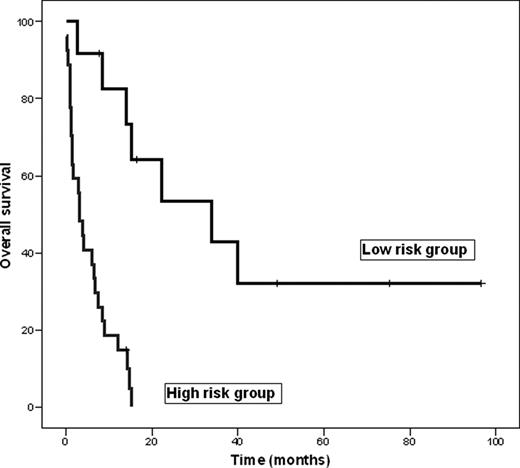Abstract
Abstract 3092
Enteropathy-associated T-cell lymphoma (EATL) is a rare intestinal lymphoma that arises from intraepithelial lymphocytes. In Western countries EATL accounts for 5% of all gastrointestinal lymphomas and in 80–90% of all cases this lymphoma is associated with celiac disease (CD). Based on clinical presentation, EATL can be divided into two subtypes: primary and secondary EATL. Primary EATL develops without a preceding history of CD. The first presentation is often perforation or obstruction, which leads to diagnosis of both EATL and CD. Secondary EATL is diagnosed in patients with well-established CD or refractory CD. These patients deteriorate and eventually develop EATL. The current standard treatment for both types of EATL consists of surgery and chemotherapy, but overall survival (OS) is poor and new therapeutic strategies are urgently needed. For risk-based selection of patients for new therapies and clinical trials, prognostic models as the International Prognostic Index (IPI) are generally used. Since IPI is not predictive for EATL, we determined a prognostic model specifically for EATL, which can identify high-risk patients who need more aggressive therapy.
Forty-one patients were diagnosed with EATL and retrospectively analyzed. Two- and 5-years OS were 18% and 10% respectively (range: 0 – 97 months). In multivariate analysis, 3 risk factors were predictive for survival: serum LDH > normal (P < 0.001; RR 6.65; 95% CI 1.96 to 9.89), presence of B-symptoms (P < 0.001; RR 4.41; 95% CI 2.73 to 16.18) and subtype secondary EATL (P = 0.036; RR 2.33; 95% CI 1.06 to 5.13). A weighted point score was assigned to each of these 3 factors and a prognostic model was constructed. Four risk groups were identified (P < 0.0001). Group I showed most favorable outcome: 2- and 5-years OS were 55% and 30% respectively. Although survival rates in groups II, III and IV were significantly different, in none of these groups 2-years survival was achieved. Therefore, the model was simplified to a low risk and a high risk group (P < 0.0001, Figure 1 ). The low risk group represented patients with no risk factors, i.e. primary EATL with no B-symptoms and normal LDH. In the high risk group, patients had 1 or more of the risk factors elevated serum LDH, B-symptoms or subtype secondary EATL. The new prognostic model showed superior predictive capacity as compared to IPI.
In conclusion, our new prognostic model clearly identifies a high and a low risk group. Patients with one or more of the risk factors serum LDH > normal, B-symptoms or subtype secondary EATL are at high risk, and therefore new therapies for this group are urgently needed.
Survival in EATL. Low risk group = no risk factors. High risk group = presence of 1 or more of the following risk factors: serum LDH > normal, B-symptoms or subtype secondary EATL.
Survival in EATL. Low risk group = no risk factors. High risk group = presence of 1 or more of the following risk factors: serum LDH > normal, B-symptoms or subtype secondary EATL.
No relevant conflicts of interest to declare.
Author notes
Asterisk with author names denotes non-ASH members.


This feature is available to Subscribers Only
Sign In or Create an Account Close Modal